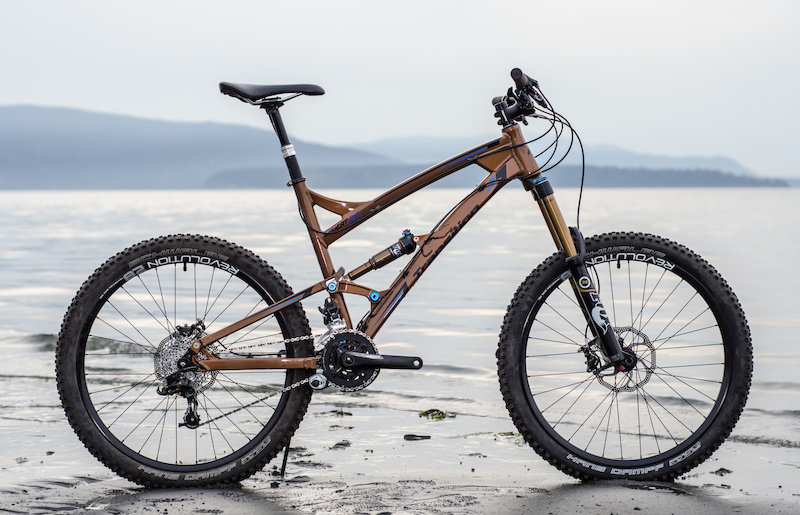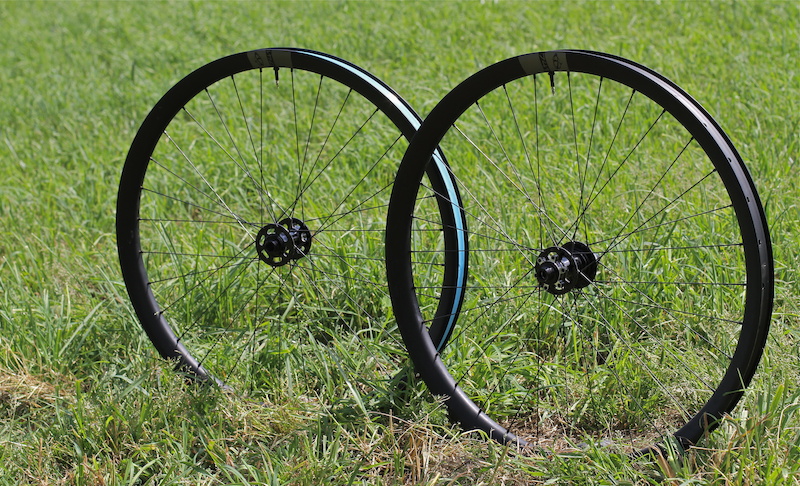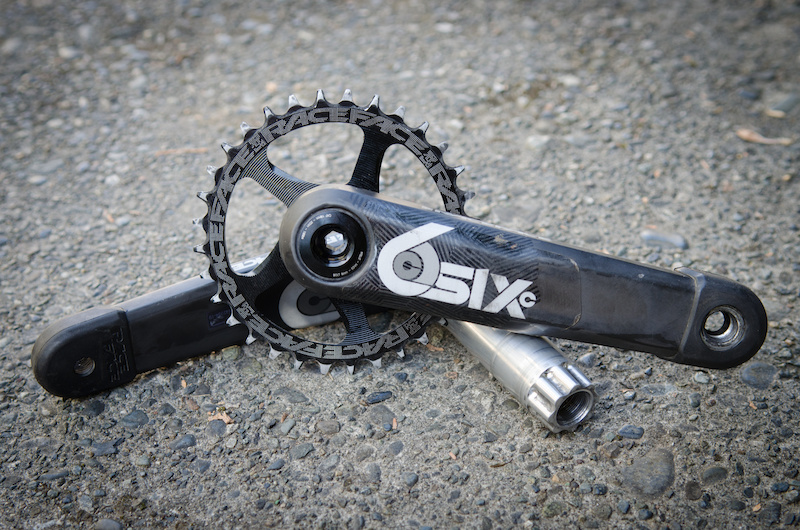Ask Pinkbike: Rim Width, Angle Headsets, and Carbon Cranks
Here at Pinkbike we get inundated with all kinds of questions, ranging from the basic "Can I have stickers" to more in-depth, soul searching types of queries like if you should pop the question or what to name your first child. Ask Pinkbike is an occasional column where we'll be hand picking and answering questions that have been keeping readers up at night, although we'll likely steer clear of those last two and keep it more tech oriented.
Rim Width Worries
Question: Pinkbike user rockhugger asked this question in the All Mountain, Enduro and Cross-Country forum: I'm considering options for a new wheel build and thinking about a wider rim that has a 31mm internal width, but I don't want to get caught up in this whole wide rim fad only to find out that it was overboard. I usually run 2.35'' wide Maxxis DHFs, as well as 2.5'' dual-ply versions for when I'm racing. Any suggestions for the best rim width for aggressive trail riding and some enduro racing?
 | I'm tempted to tell you that a wider rim is always better, but it isn't quite that simple as tire consideration needs to come into play when you get into these new mega-wide rims like Ibis' carbon 741 (35mm internal) or Specialized's carbon Fattie SL (30mm internal) and aluminum Fattie (29mm internal). How so? If you take a tire with a square profile, such as Maxxis' High Roller, and put it on an extremely wide rim, it will exaggerate that square profile to the point where it won't work as intended. That said, your DHFs have a rounder profile to them than the High Roller so they'll will work well with whatever wide rim you decide to go with, and I was quite happy with that exact setup when I tested the Ibis 741 wheelset back in June. Have these wide rims gone too far? Having spent time on them, I don't believe so. I'm confident that we'll see more and more wide rims on the market within the next year or two, simply because the benefits can't be ignored. More traction, better reliability through less burping and more tire support, and some riders can even get away with a lighter, less aggressive tire due to how a wide rim can add a few millimeters of width to the rubber. What about the added weight of a wider rim? Most of these wide rims aren't appreciably heavier than a standard option (Ibis says the 741 rim weighs 475 grams), so you can forget about that. I'd suggest going as wide as possible. If you decide to go with a complete wheelset, the carbon 741s retail for $1,299 USD, Specialized's carbon Fattie SL's go for $1,400 USD, and their aluminum Fatties for $600 USD. The latter would make a great choice if you're not looking to drop a big chunk of cash. And while Ibis' offerings only come in a pre-built wheelset, you can pick up a similar rim from Derby with a 34mm internal width for $329 USD. - Mike Levy |
Wider is better, and Ibis' 741 wheelset sports a 35mm wide (internal) rim that sounds extreme compared to the anorexic traditional rims that we're used to.
Will a Two-Degree Headset Adapter Modernize My Geometry?
Question: Nealy578 asks in the All-Mountain and Cross-Country Forum: I've seen that Works Components makes two-degree headset adapter cups. My questions is: should I purchase one to bring my Covert in to the modern slacker angles? It would bring my head angle from 66.9 to around 65-degrees. This should get it close to the new Transition Suppressor’s geo, with a little shorter wheelbase, perhaps. It should make it fun on the descents - not that it isn't already.
 | I assume that you own the 26-inch-wheel version of the Transition Covert. Pinkbike's Mike Kazimer reviewed that bike and noted that while the Covert performed well in almost every trail situation, it wasn't as good as he expected it to be on the downhills. Going from a 67-degree angle, to a 65 degree angle will make the steering feel heavy while pedaling on flats and uphills, but the benefits that the added stability and slower steering will give you on the descents may be a worthy tradeoff. You note, however, that you already like the way it descends, so using a two-degree headset cup to slacken the head angle may create a larger change in your Covert's handling than you desire. Works Components also makes 1.5-degree adapter cups, which may be a better option if you are using your Covert as a do-it-all machine. The bottom line is that it's only money. If you don't like the two-degree cups, you can always buy another set and scale your head angle back a bit. - RC |

When Pinkbike tested the Transition Covert, we thought that it needed a little help on the downs. Using one or a two-degree headset cups to slacken the head angle could do the trick.
Carbon Cranks for Dirt Jumping?
Question: PB user damonster248 asks the following in the Bikes, Parts, and Gear forum: What is your opinion about using the Race Face SixC carbon cranks for dirt jumping or slope style? Compared to such cranks as Shimano Saint or Shimano SLX.
 | Race Face's SixC carbon cranks are an impressive feat of engineering, and they held up to everything I threw at them when I tested them earlier this year. However, if I was building up a dirt jump or slopestyle rig, they wouldn't be my first choice. Why is that? Well, both dirt jumping and slopestyle riding typically involve crashing, or at least bailing, multiple times during a session, and it's often the bike that ends up taking the brunt of the impact. As strong as the SixC cranks are, carbon doesn't handle being scratched, scored, or gouged as well as aluminum, and the chances of that happening are even greater on a dirt jump bike than on a DH or all-mountain rig. A sturdy set of aluminum cranks would be a better option, and Shimano's Saint cranks would certainly be a good choice, or for a more budget friendly build I'd go with Shimano's Zee cranks over the SLX you mentioned due to their steel pedal inserts that can help prevent stripping the threads out on a hard landing. Race Face's Atlas cranks would also be another good pick, but no matter which aluminum crankset you choose to go with they'll likely be much less expensive than the SixC's $500 asking price. - Mike Kazimer |
Have some unresolved tech questions? Jump in the Pinkbike Forum and we'll look to answer it for next time.
Author Info:
Must Read This Week
Sign Up for the Pinkbike Newsletter - All the Biggest, Most Interesting Stories in your Inbox
PB Newsletter Signup




Question for PB tecks: Is 65 degrees too slack for a long travel enduro bike? Or is that the sweet spot?
I doubt it affects seat angle noticably. Why? Because the distribution of weight in the uphill also changes. By putting the front tire further ahead, more weight is now lying on the back wheel. This slackening compensates for the described steepening.
BB height is only changed very slightely whereas the BB drastically drops if you try to get the same change in head angle by offset bushings! Also, the ratio curve of the kinematics changes due to different positions of the links - and they will hardly ever change to the better...
I did a gravity clinic with WC racers Bryn Atkinson and Jill Kinter a couple weeks back. They run wide I9 rims, and said that since making the switch they've gone from preferring Minions to using HRIIs and Shortys, because the latter have a more pronounced "corner" to the tread. The find that Minion corner knobs are really on the shoulder of the tire and give good bite on narrow rims, but they "close up" on wider rims; basically they're more on the bottom/tread surface than really on the shoulder of the tire. They want aggressive corner knobs that will really bite, so they like a more square tire profile.
Anyway, I thought that was interesting, and directly opposed to ML's response above. Dunno which is right, maybe personal preference.
I rode my buddy's bike with those Stan Flow EX rims with Schwalbe tires (maybe the Magic Marys?), and with that tire the cornering felt very good. I guess it really depends on the rim/tire combo.
25mm wide rims are good for 2.3"-2.6" tires
23mm wide for 2.2-2.4" tires, or for maxxis-sized 2.35-2.5".
So I would recommend 23 to 25 mm rims for rockhugger.
Wider rims have pro and cons, but I think they needs specific tires, or wisely chosen tires.
But the stiffness and the added lightness is unbeatable.
I'm running a set of Nox Composites AM 275 at 35mm outside/29mm inside width with Vigilantes on them. Nice and round.
The grip and control are phenomenal. Sold the V10 and the 26" Enduro and have a garage full of tubeless Minion 2.5s as a result.
My opinion is that a wider rim on a similarly sized tire exposes the outside of your rim to rocks. If you typically ride on very smooth trails this shouldn't be an issue but for me, I haven't been able to take advantage of this "new technology." Is anyone else noticing this??? Maybe specialized rims are soft? I'm genuinely curious...
"In 2013 the first wide carbon fiber rims came out, called Derby Rims. Derby is our good friend and in fact Ibis liked his idea so much we funded half the original tooling expense of these rims. Having access to the Derby Rims proved invaluable in testing for our own concepts and designs. Derby’s rims are made in a different factory than ours, as we will be needing a much larger quantity than his source can provide.
For now, we will only be selling complete wheels, so if you’re looking for rims only, we heartily endorse the product that Derby is selling. If you can get them that is, Derby Rims have been regularly selling out each production run."
www.pinkbike.com/photo/11522266
I'm not sure aluminum wouldve fared any better, but they defnitely can explode
Aggy bailed over the Polaris hip jump throwing his bike from an extreme height. The bike landed on the drive side directly on the pedal and bars. This damaged the crank, derailleur hanger, bars, brake lever, and other parts.
An impact like that from the side of the bike is not what those parts were designed to sustain. The damaged parts DID NOT CAUSE Aggy's bail, they were a product of his bailing and tossing the bike.
I agree that carbon cranks on a dirtjumper are silly. I believe that all else regarding carbon cranks is opinion here. I just wanted to clear up your initial statement which was not true.
Your picture shows it perfectly, the crank broke on impact. He did not land on/with the bike, so is your assumption that the crank magically broke mid air or before the jump and stayed perfectly with the bike until the impact? nope.
Go huge like aggy, toss your bike, if it lands directly on the pedal and generates massive side loads, your crank may break. That is all there is to it.
There is a reason why there is no "scientific data" shown by almost any company - because none of any quality is ever produced. There are very few companies dedicated to testing like for example Syntace. The industry has a remedy for it: it is called low cost, high margin production, paying itself off in ability to pay insurance, warranty and eventual recalls. Finally lack of "scientific data" is good for marketing, they can propell as many half-truths and pseudo-science as they want. A science that truly works in cycling industry is psychology of purchase.
Disclaimer: that was nothing negative against you, I am with you, just clarifying PB engineering.
Science has replaced Church - people eagerly seek a man who will tell them a complicated story on how the world works and their lack of knowledge in a specific area forces them to use faith, a belief that what he says is true.
Carbon=Very Expensive, not a huge weight saving to justify the price, questionable reliability. Still haven't proved to the consumer that it's better than Ali (read above comments)
Aluminium=Great Value, still light, LIFETIME WARRANTIES (Unlike your carbon cranks Raceface!!), Proven strength and durability, full consumer confidence.
I'm sure you will all tell me if I'm wrong.
take my money Ibis
www.workscomponents.co.uk/15-degree-ec44---zs56---to-suit-tapered-steerer-tube-forks-138-p.asp
The ZS stands for "zero stack" while EC stands for "external cup" or something similar. The numbers are the ID of the frame (OD of headset cups)
The stick example is also correct but you are forgetting this is not a vertical to angle example is it? Imagine pushing on a 65degree stick then a 63 degree one = almost no difference.
It is an interesting question... just how tough are carbon cranks. So far I've only heard (and provided) anecdotes. My observation is that there is nothing to suggest that carbon is more likely to break.
I've bent an aluminum crank (spider) beyond being able to use it. I've yet to do that to carbon. Not that this proves anything.
I've got Powerbites on now, and they're solid as Fu¢k.(literally and figuratively)
But yah I agree, the difference isn't worth the cost
Carbon cranks are solid as hell and hold up just fine after being gouged. On top of this, they typically only get damaged from rock stikes at the tip of the crank. Plastic crank boots solve that problem.
In other words, there is no evidence that i'm aware of to suggest that carbon cranks can't handle damage like aluminum cranks.
Scratched aluminium is just "meh, whatever", but if you scratch carbon you're going to compromise the structure and arrangement of the carbon fibres, thus weakening the component (because without a proper structure and arrangement of the fibres, carbon is pretty much just regular plastic)
Matt76 - I was referring to the ultra light weight carbon bars weighing in at 180g to 200g. The renthal you mention is indeed thicker and is also almost 50% heavier. Again, distinguishing between thick and thin materials is critical. Ultra thin walled components can be ruined by minor surface damage. The same is not true of thick walled components.
i will presume this will be downvoted too
When you say "carbon tends to fail", i presume that to mean in theory. There's no evidence that modern free-ride or DH specific carbon components and frames have a higher failure rate than aluminum.
www.irishtimes.com/sport/other-sports/carbon-fibre-bicycles-in-the-frame-for-rising-number-of-injuries-1.1879653
Most of the carbon fibre I have seen with 'catastrophic failure' has been involved in an impact way beyond a reasonable engineering scenario like riding square into a tree at 30mph, driving into a garage with bike on roof of automobile, or the cyclist being run over by an automobile on the highway.
The carbon fibre I have seen with some mode of failure but not catastrophic (i.e. slowly propagating crack in frame) has been determined to be from issues with design/engineering (you see the same issue on repeated units of the same model), quality control during manufacturing (bad layup, issues with handling damage to cloth) or historical legacy (metallic elements moulded into carbon fibre i.e. BB shell causing galvanic corrosion over several seasons)
I've seen a lot of broken CF and Aluminum alloy parts. I happily run a road bike and mountain bike both with CF frames, CF seatposts, CF bars.
I would not use CF crankset because there seems to be no real advantage, and a huge cost penalty. Several years back, Shimano (easily the leading producer of cranksets) brought a CF "Dura Ace" road crankset to market. Then withdrew the crankset as there was no advantage over their duraluminium model, a big cost penalty and rumours had surfaced of failures with the CF crank.
Also seen a good number of bent aluminium alloy cranksets from Shimano, RF, SRAM / truvativ and other smaller brands, but very few that have failed completely - I've seen more broken cromoly steel cranks from Profile when I rode BMX for many years - seeing something skating across the floor of the skatepark and its a Profile race crank arm with pedal, the arm has sheared off at the axle boss where the weld has failed.
Bending is a good safe mode of failure for the rider, a sudden failure can easily cause a broken ankle, broken leg or other serious injury if the rider is thrown off the bicycle at high speed.
The CF cranks seem to be the ones with the catastophic failure, probably from previous impact damage compromising the CF structure.
Alloy cranks seem to take a regular beating with little consequence. Of course, its wise to always inspect your equipment before riding. The tricky thing with CF is you cannot really determine what the previous impact did to the structure, unless you have access to NDT equipment which is beyond the cost and availability to most riders, let alone companies.
The W35MX rims are a top of my list. The hubs are pretty cool too.
How do know if your Anglesey headset is in perfectly strait?
And do you feel any flex in carbon cranks?
2) I don't have experience with Anglesets so I can't help you with that.
3) I wouldn't worry about flex with carbon, carbon when done correctly makes for an incredibly stiff product.
So if we don't suggest such a change would it be wise to use an angleset that will create the same effect?
Anyways, this is 2014, manufacturers like commencal, scott, intense etc etc all spec bikes with anglesets etc - its a total non issue.
Carbon cranks seem hit and miss, seen some break and some last 2 seasons...
As racer951 said above there is no real increase in leverage and as the angle change is quite small in real terms ( less than 5% of original) additional frame stress is minimal.
We have made 3.0 degree headets in the past for wc dh teams and in many years of trading have not received one report where a user has believed frame failure was brought about as a result of our headset being fitted. Thanks, Rick@works